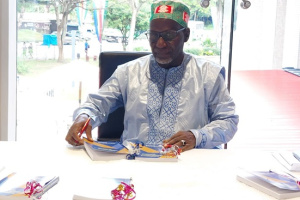Abdourahamane Diallo publishes book on Seychelles' old lullabies and Moutya songs
Arts & Culture |Author: Rita Joubert-Lawen Edited by: Betymie Bonnelame | June 23, 2024, Sunday @ 08:10| 95739 views
The book, which contains 40 Moutya songs and 30 lullabies, is the result of research and collection of data by Abdourahamane Diallo. (SNICHA)
(Seychelles News Agency) - The history of lullabies sung to children and lyrics of Moutya songs in Seychelles are at the heart of the book entitled "Chanson Moutya et Berceuses Traditionnelles Des Seychelles (Moutya Songs and Traditional Lullabies) launched on Thursday at the National Library.
The book, which contains 40 Moutya songs and 30 lullabies, is the result of research and collection of data by Abdourahamane Diallo, who initially came from Guinea to the country as a French teacher, which started between 1980 and 1983.
In his address, Diallo said, "The publication of this history aims to disseminate, share, and safeguard the rich heritage of Moutya. It seeks to make this dynamic oral tradition accessible to local and international audiences, ensuring that Seychelles' cultural heritage is preserved and celebrated worldwide."
He shared that "work on the basic documents for this work dates back to the early 80s by the team based at La Bastille, made up of Eudoxie Labiche, Gabriel Essack and our late Marcel Rosalie."
The team went to various islands to collect these songs, namely Mahe, Praslin, La Digue, the most populated islands of Seychelles, and Silhouette.
"The Moutya is the first part of our heritage to be included on the UNESCO Intangible Cultural Heritage list, as of 15 December 2021. So the Moutya has been passed down from generation to generation, right up to the present day, having survived despite adversity, with a new and recognised status," highlighted Diallo.
The Moutya dance was introduced to the Seychelles, an archipelago in the western Indian Ocean, by enslaved Africans who arrived there with French settlers. It was originally performed around a bonfire, deep in the forest in the dead of night. The dance was an expression of resistance, allowing enslaved people to share their suffering and sing about the difficulties they faced, far from their masters' ears.
"It tells stories of oppression and was later used as revenge against the colonising powers," said Diallo.
Copies of the book are available to read at the National Library in the capital of Victoria.
This is Diallo's second book sponsored and published by the National Arts and Culture Fund. His first book entitled "Les Écrivains Seychellois" (The Seychellois Writers), was launched in 2019.
Back
